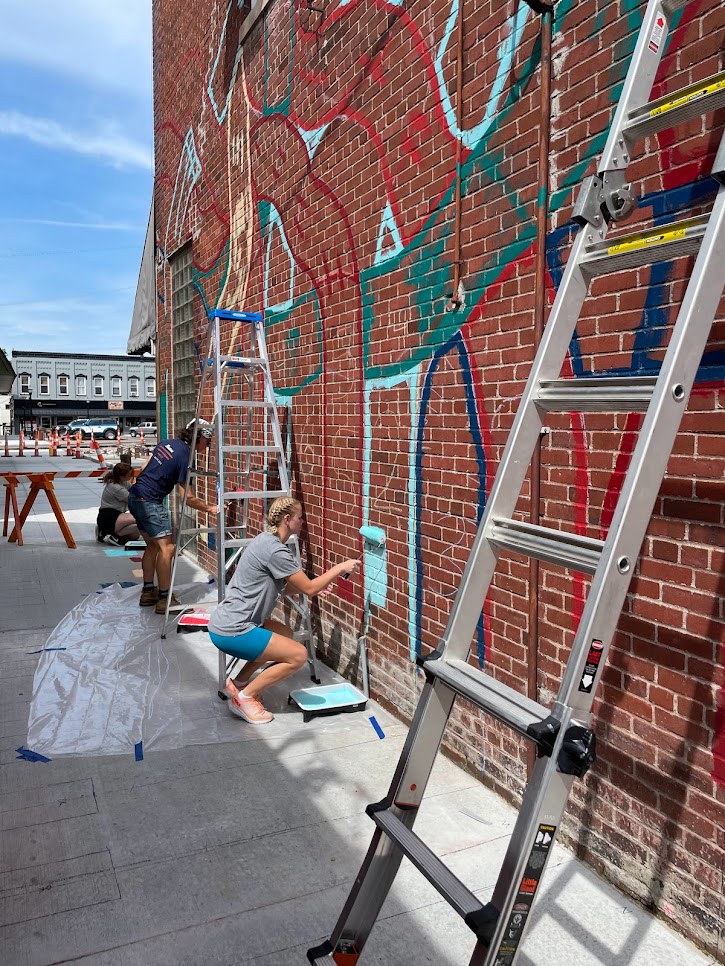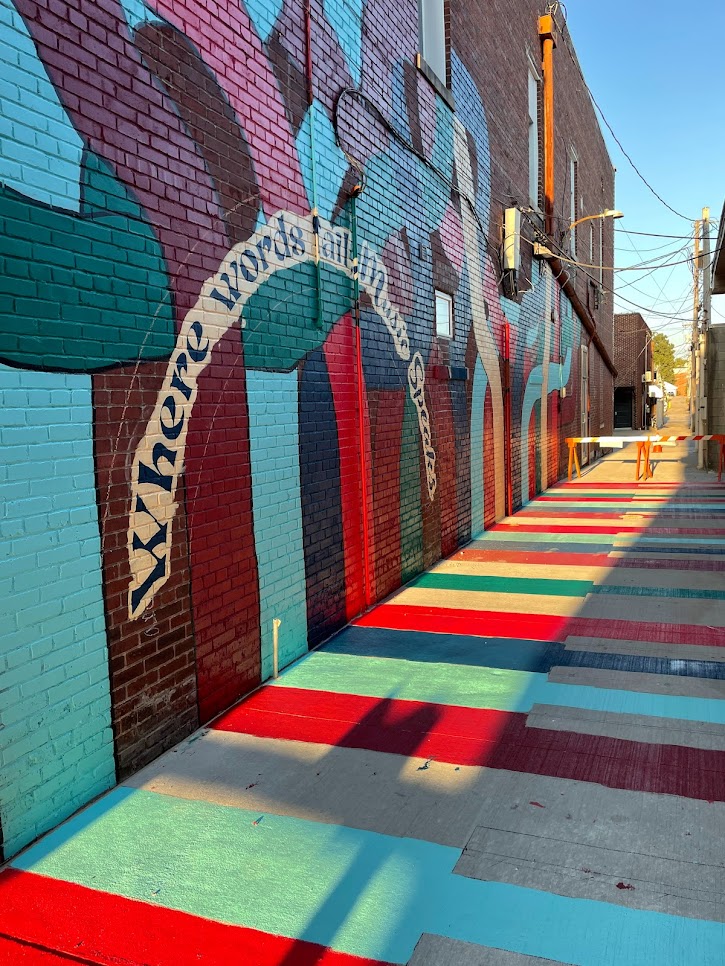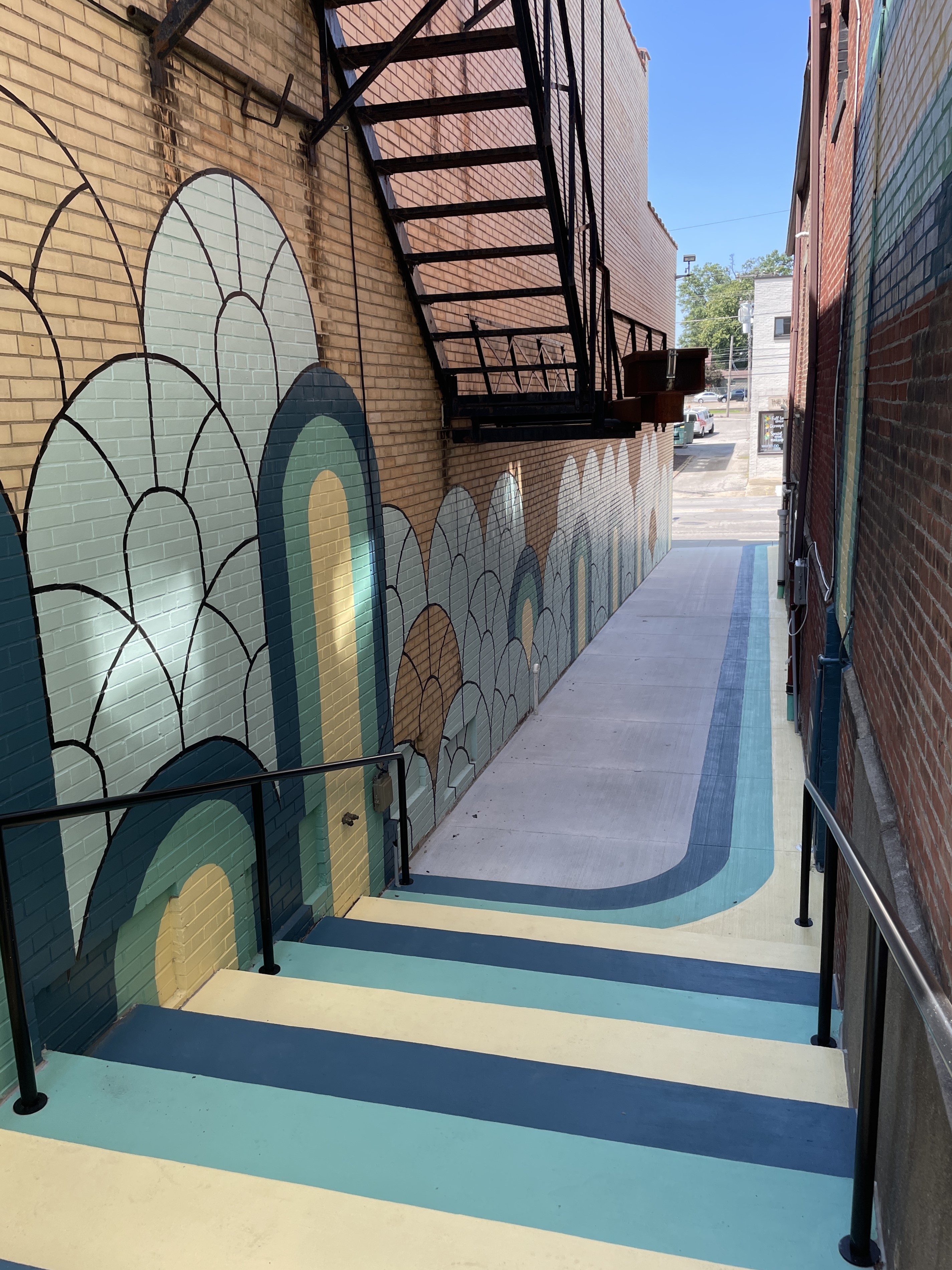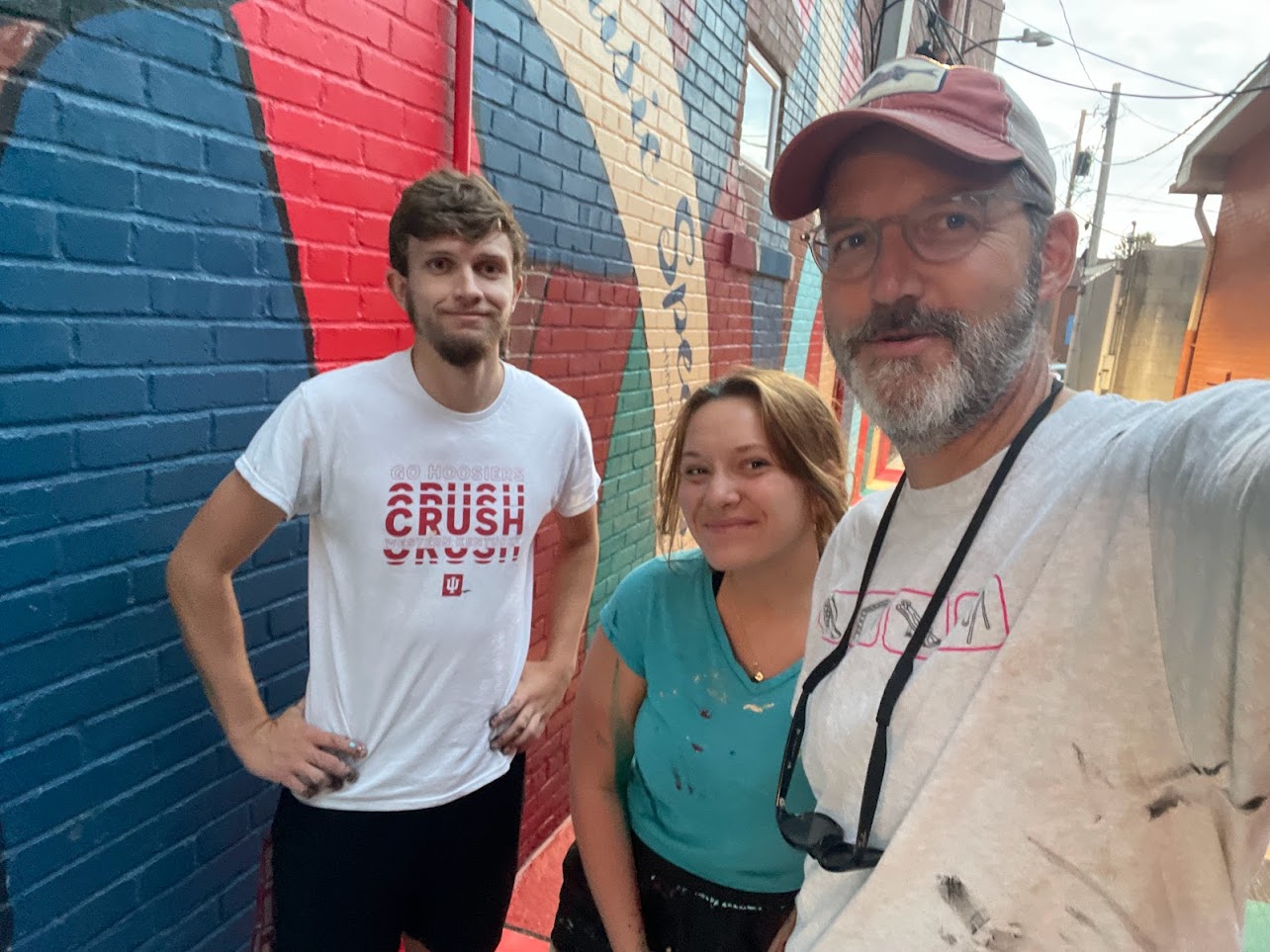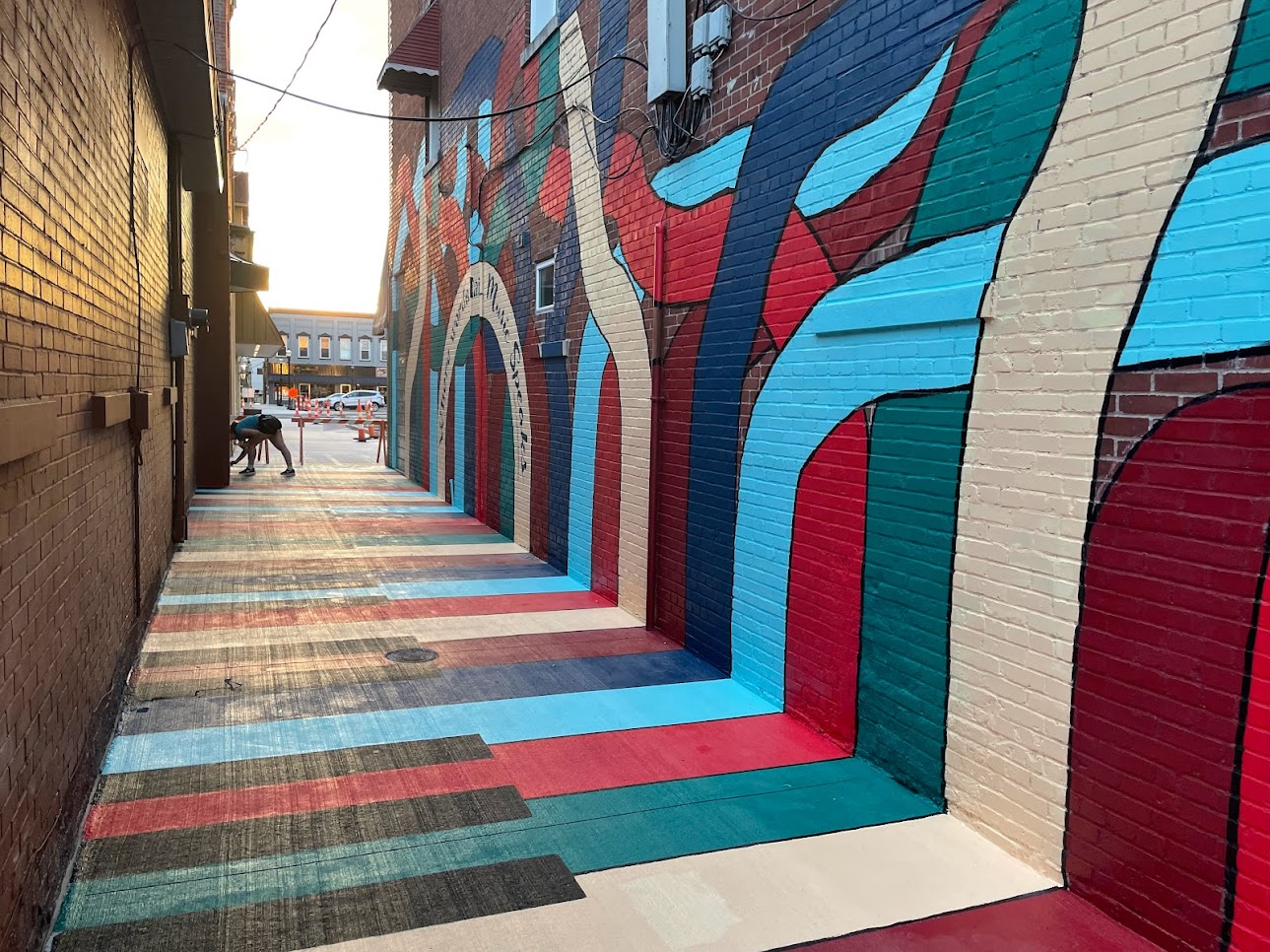Jasper, Indiana was once the piano capital of the world. The installation of a new mural in the small southern Indiana redounds to that legacy. In partnership with the City of Jasper, the Dubois County Community Foundation, the Heart of Jasper organization, and the Indiana University Center for Rural Engagement (CRE), students and faculty from the IU Eskenazi School of Art, Architecture + Design’s worked through the school’s ServeDesign Center on a public art project bolstering the city’s efforts to revitalize its downtown.
A dedication ceremony for what has come to be known as Piano Alley takes place Tuesday, October 10 at 4 p.m. on Jasper’s downtown square.
Read coverage of the dedication in the Dubois County Free Press
The project transforms an alley just off the southeastern corner of the downtown square with a multicolored abstract mural, extending across the walkway and up to the second story of the adjacent building. An adage arcs across the center of the brick wall: “Where words fail, Music Speaks.” The colorful stripes down the alley that alternate with black keys reinforce the musical motif, a reference to Jasper’s onetime preeminence in piano manufacturing.
Jasper was long home to the Kimball brand, which in 1969 was the world’s largest piano maker. Although Kimball began as a piano dealership in Chicago in the 19th century, it was eventually acquired by the Jasper Corporation in the 1950s. At the time of the acquisition, Kimball’s market share was flagging. The Jasper Corporation ramped up piano production in its West Baden manufacturing facility, merged with Austrian piano maker Bösendorfer, and restored the Kimball brand to top of the global piano market. Changing its name to Kimball International, the Jasper company subsequently expanded into office and hotel furniture manufacturing, producing its last piano in 1996.
Working with downtown stakeholders, the ServeDesign team reprised the city’s musical history for the mural. ServeDesign matches projects in communities near and far with Eskenazi students and faculty, obtains grant funding, and provides service-learning training. Piano Alley is the second alley activation project ServeDesign has undertaken in Jasper.
Last year, as CRE’s quality of place intern, comprehensive design student Hannah Jones (B.S. ’23) worked with the City of Jasper to assess its plans for a grant-funded alley activation and mural project. A comprehensive scheme incorporating lighting, seating, and a mural, the resulting Astra Alley took its name from the adjacent Astra Theatre, the city’s historic movie house at 517 Main Street.
“Hannah’s work was so outstanding that not only did the city receive the grant,” said Eskenazi faculty and ServeDesign Director Jon Racek, “but the work’s level of sophistication allowed the contractors to work directly from her plans to have the mural painted and the lighting installed, and to investigate the construction costs of wooden and concrete outdoor furniture modules.”
Based on the success of that collaboration, CRE asked ServeDesign to participate in a second alley project in Jasper this year. With interior design student Katie LaTorre (expected B.S. ’25) succeeding Jones as quality of place intern and comprehensive design student Hayden Grider (expected B.S. ’24) functioning as project manager, they embarked on an iterative process with the Jasper clients to establish and refine the mural’s design.
Once agreed upon, the design was chalked out in broad strokes, each section was numbered, and a team of six comprehensive design students were assigned to paint sections using the colors associated with each number. The team leaders added the finishing touches and superimposed the black lines between elements.
“This was not only my first alley project, but also my first design project that didn't involve the actual design of a building,” said LaTorre. “I learned so much and gained a different perspective of how important projects like this are towards elevating a small town's history and heritage.” The interior design major is minoring in entrepreneurial business, with plans to pursue an M. Arch degree after graduation.
"This project was a great opportunity for students to design, plan, and implement a project,” said Racek. “The community was a great partner and everyone is so pleased with how the things worked out."
“If the people in the community are happy with it and proud to have it on their walls, then that is a success for me,” said Grider, who is earning a studio art minor in addition to his B.S. in comprehensive design.
Piano Alley complements a robust program of public art in Jasper. In addition to the two ServeDesign projects, the city in September unveiled “River of Dreams” by artist Laura Pommier at the Jasper River Walk and a historical tableau also by the Jasper native at the Dubois County Visitors’ Center (248 Third Street). Since 2015, Michael Smith’s mural at Newton and Sixth Streets has commemorated the city’s industrial, mercantile, and agricultural history. Finally, Jasper has a treasure for enthusiasts of the golden age of 20th-century American public art: a post office mural commissioned by the Works Progress Administration, a New Deal program. Located in the lobby of the Jasper Post Office, “Indiana Farming Scene in Late Autumn” is a 1939 mural by Jessie Hull Mayer (see more at New Deal Art Registry).


